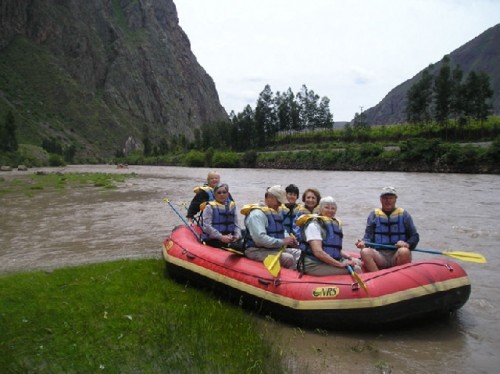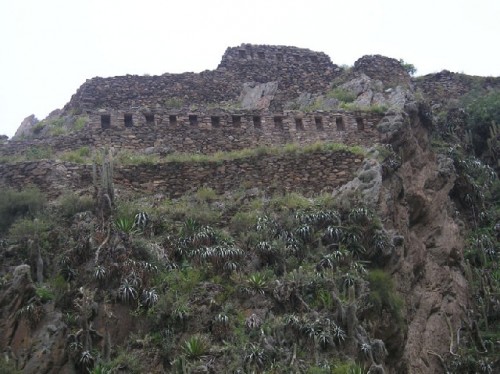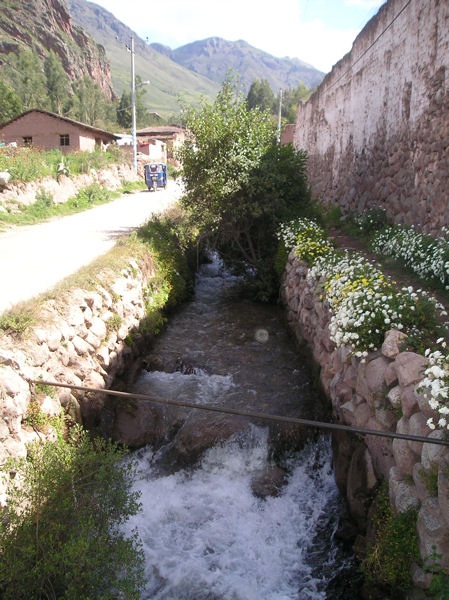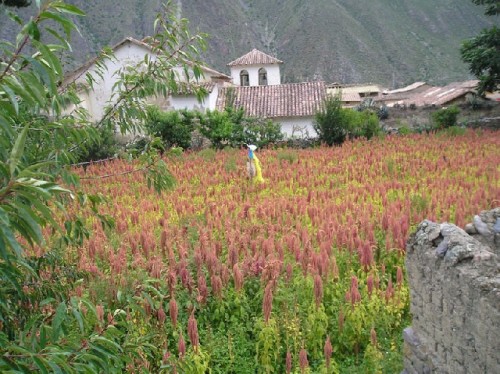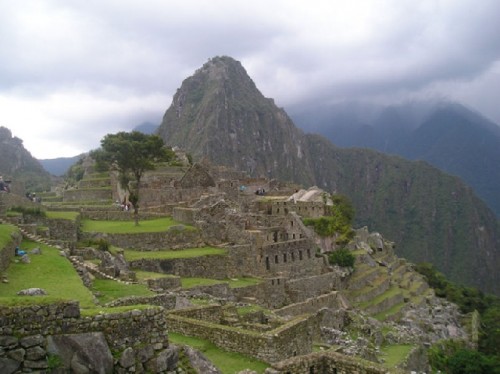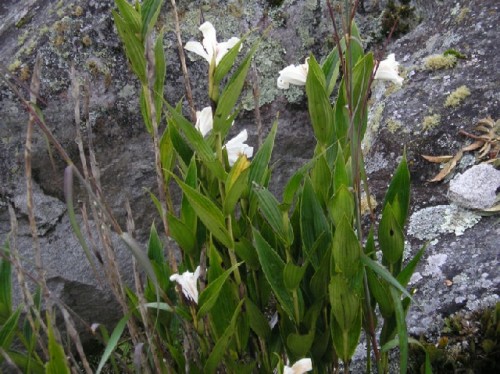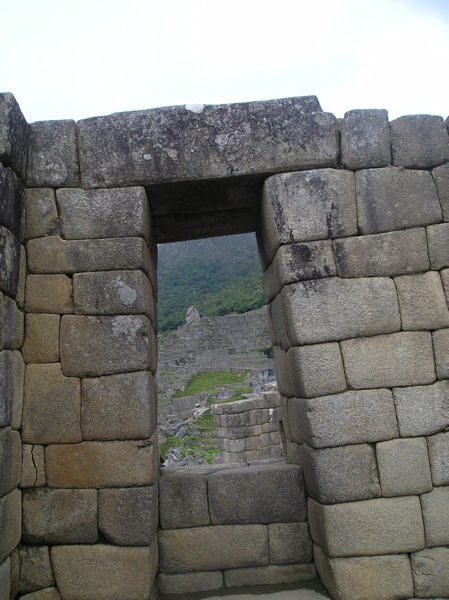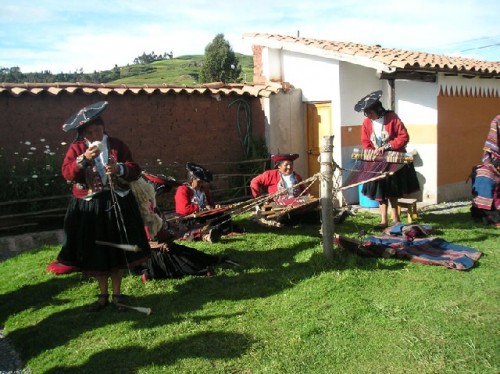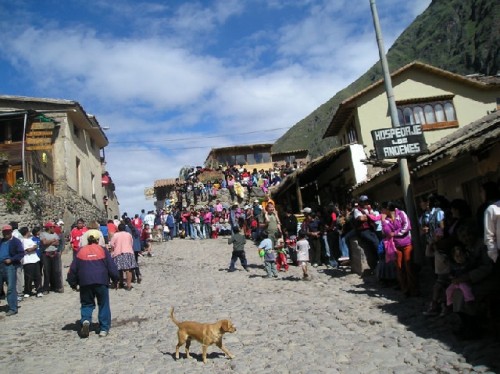Peru: Part Two
Sacred Valley and Machu Picchu
By: Zeren Earls - Sep 13, 2007
Sacred Valley
Excited about the trip on inflatable rafts, we drove up the Urubamba Valley. Large puppets representing godmothers hung from telephone wires or trees by or in front of homes. Since godmothers pledge to take care of the children in case something happens to their parents, they are honored with gifts and rituals on a special day annually. We were fortunate enough to have several viewing opportunities commemorating this day. We also stopped at the Friday Market. Testimony to the mild climate and fertile soil of the Valley, on the ground lay an abundance of fruits and vegetables: mounds of corn, sacs with potatoes of every color, heaps of cabbage, carrots, onions, avocados, mangoes, peaches etc. Guinea pigs, rabbits and chickens were a riotous sight. Roasted guinea pig is an Andean delicacy.
The rafting trip on the Urubamba River was a wonderful excursion. Donning a life jacket and carrying a paddle, we filed into two inflated boats. This first time experience quickly taught me the importance of paddling in unison, especially when the water got rough. As we floated along the river, we were surrounded by steep hills. A network of hand-constructed terraces transformed the mountainside into velvety arable land. Afterwards, while the boat crew fixed a picnic lunch, we visited the fortress of Ollantaytambo, an Inca sacred place, which includes the unfinished Temple of the Sun in front of large boulders.
On the way back we stopped at a chicharia, a place where locals enjoy chicha, the traditional homemade alcoholic brew. On the floor large urns covered with cloth stored the white, frothy corn beer. An acquired taste for Westerners, it is drunk in large quantities by Andeans at festivals or simply to get through the day. The non-alcoholic version, chicha morada, is made with purple maize.
The evening treat was a home-hosted dinner. Our farmer host and his seven-year-old twin daughters greeted us at the door. We met his wife and mother-in-law, as well as his houseguests, two young men who had traveled far to earn money for schoolbooks while harvesting corn. We sat at a long table covered with multiple colorful cloths, arranged diagonally. Hand-loomed textiles adorned the walls; one served as a backdrop for a three-dimensional Christ figure. Otherwise the living/dining room was sparse. Our multiple course dinner began with a hearty soup and ended with a home baked cake. Our host and his wife spoke limited English, and everyone else spoke only Quechua. Despite our mutual limitations, we thoroughly enjoyed the evening. The twins entertained us with English songs, such as Old MacDonald that they had learned from other visitors. We each presented a gift before departing; all appreciated the ballpoint pens I gave.
Machu Picchu
The train ride to Machu Picchu on my birthday made it a very special day. On the way to the station at Ollantaytambo we stopped at a Catholic cemetery. With the mountains as a backdrop, it was a beautiful spot. Tombs fashioned out of marble with small chambers for memorabilia behind protective glass constituted the affluent section. Crosses amidst flowers punctuated the plot of the modest part. Then we had a short tour of Ollantaytambo and its charming central square. In this best preserved of Incan towns, the old walls of the houses are still standing, and water runs through original channels in narrow streets.
Run by Orient Express International, Vistadom is a rail service to Aguas Calientes, twenty-minutes away from Machu Picchu by bus. The trip is $36 each way and takes one and a half hours. The train pulled up to the platform at 10:20 am and after a quick cleanup and snack replenishment departed promptly as scheduled at 10:30. Wobbling on narrow tracks it entered the gorge of the Urubamba River rocking me to sleep. I dozed on and off enjoying the scenic ride. We reached our destination in time for lunch at the hotel, sited right on the river. To have a relaxed pace at Machu Picchu, we spent two nights here. Traveling only with a night-pack, we claimed our luggage in Cusco.
As soon as we cleared the crush of people at the turnstiles and began climbing, Machu Picchu's breathtaking beauty surrounded us. Under a cloudless sky the ancient Incan city spread out between majestic peaks. Having escaped the destruction of the Spanish as a deserted city, the archeological remains of the religious center of Incan life create a magical presence across the mountain landscape. The vast compound set within agricultural areas includes temples, royal enclosures, tapering towers, houses, storage huts, an observatory and sacrificial sites. The walls are built with grayish white granite and fitted without mortar like a jigsaw puzzle. They have niches for idols and offerings. The trapezoid shape used for gates and windows provides structural tension between the massive stones, while also framing fantastic views. How these gigantic stones were cut by using only smaller sharp stones and then lifted is astonishing.
Unknown to the outside world until a farmer led Yale scholar Hiram Bingham there in 1911, Machu Picchu is now a UNESCO World Heritage Site. As we walked among ruins we spotted Andean birds, petted llamas and identified wild flowers that were in full bloom. Descending for our return, I felt like a pilgrim at her destination. I could not have picked a more auspicious place for my birthday.
Back at the hotel Walter had a birthday surprise. He had ordered a cake with a single candle. When it was time to blow it out I realized its trick. Yet another new experience - at the age of 70 I learned about trick candles! Dinner was on our own that night. A few of us tried an Italian restaurant. Friends met on this trip treated me to dinner; I felt grateful for the camaraderie that we had quickly developed.
The next morning we rose early to have a second look at Machu Picchu. It was raining, so Sumru and I had to let go of the option to climb the steep Huayna Picchu, fearing slippery wet steps. Instead we joined the hikers to the Sun Gate, a small Inca ruin set in a mountain pass above the city. The three-hour trip there and back on the partially stone-paved Inca Trail was an adventure in the fine rain. With clouds shrouding the distant mountain peaks, we walked above and through those moving near us. Orchids along the trail punctured the haze, with their intense blue and magenta colors brightening the mountainside. Friendly llamas seemed to appear out of nowhere. The natural beauty around me was so amazing that I kept taking photos.
The trail ended at the Sun Gate, the site for sacrificial rites of the Inca, whose name means "son of the sun". Here on the shortest day of the year, heads of llamas were offered to condors, the majestic Andean bird and "protector" of the skies. The downhill return was slower than I had anticipated due to wet ground. Although I had shoes with good traction, each step required caution. Those with hiking boots were able to pick up speed. At the gate we had our passports stamped as a souvenir. At lunch the vegetable soup hit the spot, as I was quite chilled. After a cup of Manzanilla (Chamomile) tea, a common beverage to finish the meal, I was all set to continue.
As luck would have it this was the first day of carnival week. The train crew, some in masks, put on an entertaining fashion show on the ride back to Ollantaytambo. Then, connecting to our bus, we headed for Cusco, stopping on the way at the small village of Chincero to visit a textile cooperative, where weavers introduced us to the traditional art of the back strap loom. Worn by the weaver, the portable loom provides for a mobile workplace - home, field and market. Following a demonstration of the types of wool, alpaca, llama, vicuna and sheep - by feel to the hand, we learned about the different processes of spinning, dying and weaving. Vicuna wool is the finest and the most expensive, because this rare animal can be shorn only about every third year and produces a very small amount of wool. Alpacas can only be shorn on alternate years, but yield a greater amount of wool, which is finer than that of the llama.
As we came upon carnival festivities we got out of the bus to view them. Women in layered skirts and men in knitted hats danced around trees festooned with balloons and gifts. The celebrants enjoyed spraying one another with shaving cream or drenching each other with buckets of water. The roadside fields turned into a patchwork of varying shades of green as we continued. We passed by potato fields with purple and white flowers and others with maize, quinoa and fava beans. At the end of an adventurous day we finally arrived in Cusco. After a delicious grilled chicken dinner with a sliced avocado appetizer at the hotel, I dropped off to sleep.

